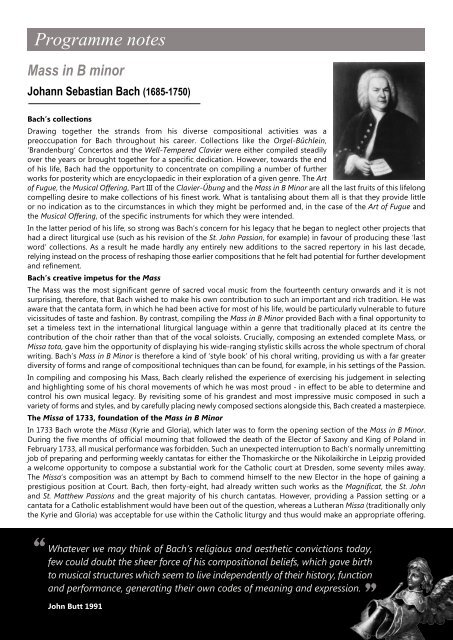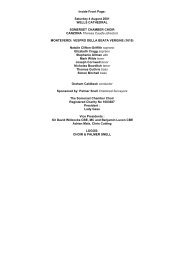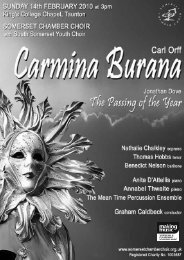Click here to view the concert programme - Somerset Chamber Choir
Click here to view the concert programme - Somerset Chamber Choir
Click here to view the concert programme - Somerset Chamber Choir
Create successful ePaper yourself
Turn your PDF publications into a flip-book with our unique Google optimized e-Paper software.
Programme notes<br />
Mass in B minor<br />
Johann Sebastian Bach (1685-1750)<br />
Bach’s collections<br />
Drawing <strong>to</strong>ge<strong>the</strong>r <strong>the</strong> strands from his diverse compositional activities was a<br />
preoccupation for Bach throughout his career. Collections like <strong>the</strong> Orgel‐Bűchlein,<br />
‘Brandenburg’ Concer<strong>to</strong>s and <strong>the</strong> Well-Tempered Clavier were ei<strong>the</strong>r compiled steadily<br />
over <strong>the</strong> years or brought <strong>to</strong>ge<strong>the</strong>r for a specific dedication. However, <strong>to</strong>wards <strong>the</strong> end<br />
of his life, Bach had <strong>the</strong> opportunity <strong>to</strong> concentrate on compiling a number of fur<strong>the</strong>r<br />
works for posterity which are encyclopaedic in <strong>the</strong>ir exploration of a given genre. The Art<br />
of Fugue, <strong>the</strong> Musical Offering, Part III of <strong>the</strong> Clavier‐Űbung and <strong>the</strong> Mass in B Minor are all <strong>the</strong> last fruits of this lifelong<br />
compelling desire <strong>to</strong> make collections of his finest work. What is tantalising about <strong>the</strong>m all is that <strong>the</strong>y provide little<br />
or no indication as <strong>to</strong> <strong>the</strong> circumstances in which <strong>the</strong>y might be performed and, in <strong>the</strong> case of <strong>the</strong> Art of Fugue and<br />
<strong>the</strong> Musical Offering, of <strong>the</strong> specific instruments for which <strong>the</strong>y were intended.<br />
In <strong>the</strong> latter period of his life, so strong was Bach’s concern for his legacy that he began <strong>to</strong> neglect o<strong>the</strong>r projects that<br />
had a direct liturgical use (such as his revision of <strong>the</strong> St. John Passion, for example) in favour of producing <strong>the</strong>se ‘last<br />
word’ collections. As a result he made hardly any entirely new additions <strong>to</strong> <strong>the</strong> sacred reper<strong>to</strong>ry in his last decade,<br />
relying instead on <strong>the</strong> process of reshaping those earlier compositions that he felt had potential for fur<strong>the</strong>r development<br />
and refinement.<br />
Bach’s creative impetus for <strong>the</strong> Mass<br />
The Mass was <strong>the</strong> most significant genre of sacred vocal music from <strong>the</strong> fourteenth century onwards and it is not<br />
surprising, t<strong>here</strong>fore, that Bach wished <strong>to</strong> make his own contribution <strong>to</strong> such an important and rich tradition. He was<br />
aware that <strong>the</strong> cantata form, in which he had been active for most of his life, would be particularly vulnerable <strong>to</strong> future<br />
vicissitudes of taste and fashion. By contrast, compiling <strong>the</strong> Mass in B Minor provided Bach with a final opportunity <strong>to</strong><br />
set a timeless text in <strong>the</strong> international liturgical language within a genre that traditionally placed at its centre <strong>the</strong><br />
contribution of <strong>the</strong> choir ra<strong>the</strong>r than that of <strong>the</strong> vocal soloists. Crucially, composing an extended complete Mass, or<br />
Missa <strong>to</strong>ta, gave him <strong>the</strong> opportunity of displaying his wide-ranging stylistic skills across <strong>the</strong> whole spectrum of choral<br />
writing. Bach’s Mass in B Minor is t<strong>here</strong>fore a kind of ‘style book’ of his choral writing, providing us with a far greater<br />
diversity of forms and range of compositional techniques than can be found, for example, in his settings of <strong>the</strong> Passion.<br />
In compiling and composing his Mass, Bach clearly relished <strong>the</strong> experience of exercising his judgement in selecting<br />
and highlighting some of his choral movements of which he was most proud - in effect <strong>to</strong> be able <strong>to</strong> determine and<br />
control his own musical legacy. By revisiting some of his grandest and most impressive music composed in such a<br />
variety of forms and styles, and by carefully placing newly composed sections alongside this, Bach created a masterpiece.<br />
The Missa of 1733, foundation of <strong>the</strong> Mass in B Minor<br />
In 1733 Bach wrote <strong>the</strong> Missa (Kyrie and Gloria), which later was <strong>to</strong> form <strong>the</strong> opening section of <strong>the</strong> Mass in B Minor.<br />
During <strong>the</strong> five months of official mourning that followed <strong>the</strong> death of <strong>the</strong> Elec<strong>to</strong>r of Saxony and King of Poland in<br />
February 1733, all musical performance was forbidden. Such an unexpected interruption <strong>to</strong> Bach’s normally unremitting<br />
job of preparing and performing weekly cantatas for ei<strong>the</strong>r <strong>the</strong> Thomaskirche or <strong>the</strong> Nikolaikirche in Leipzig provided<br />
a welcome opportunity <strong>to</strong> compose a substantial work for <strong>the</strong> Catholic court at Dresden, some seventy miles away.<br />
The Missa’s composition was an attempt by Bach <strong>to</strong> commend himself <strong>to</strong> <strong>the</strong> new Elec<strong>to</strong>r in <strong>the</strong> hope of gaining a<br />
prestigious position at Court. Bach, <strong>the</strong>n forty-eight, had already written such works as <strong>the</strong> Magnificat, <strong>the</strong> St. John<br />
and St. Mat<strong>the</strong>w Passions and <strong>the</strong> great majority of his church cantatas. However, providing a Passion setting or a<br />
cantata for a Catholic establishment would have been out of <strong>the</strong> question, w<strong>here</strong>as a Lu<strong>the</strong>ran Missa (traditionally only<br />
<strong>the</strong> Kyrie and Gloria) was acceptable for use within <strong>the</strong> Catholic liturgy and thus would make an appropriate offering.<br />
"<br />
Whatever we may think of Bach’s religious and aes<strong>the</strong>tic convictions <strong>to</strong>day,<br />
few could doubt <strong>the</strong> sheer force of his compositional beliefs, which gave birth<br />
<strong>to</strong> musical structures which seem <strong>to</strong> live independently of <strong>the</strong>ir his<strong>to</strong>ry, function<br />
and performance, generating <strong>the</strong>ir own codes of meaning and expression.<br />
John Butt 1991<br />
"












